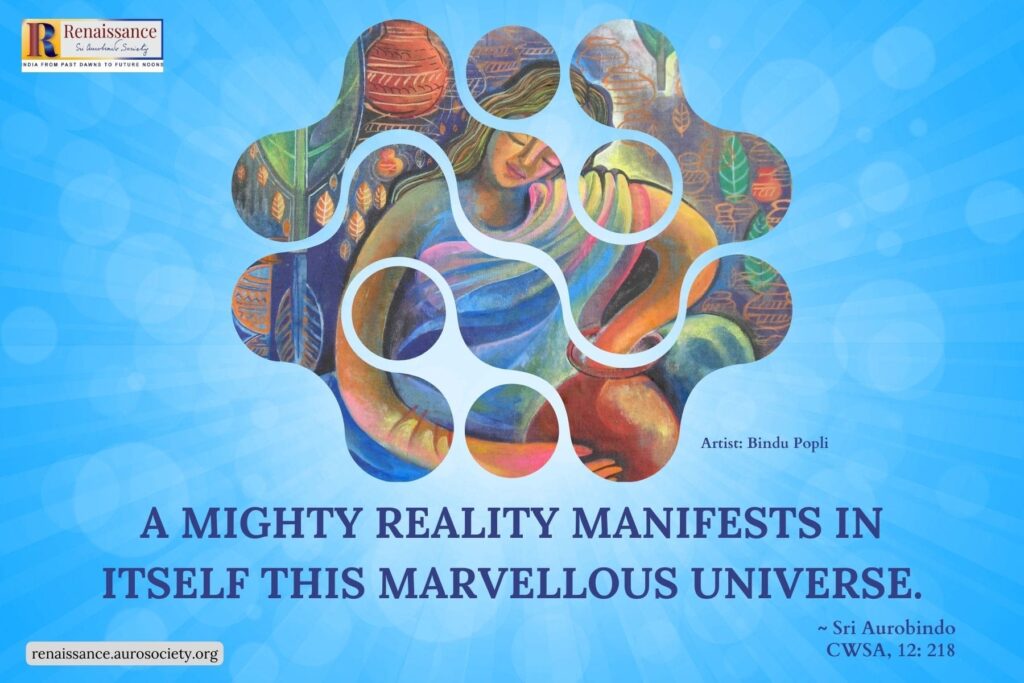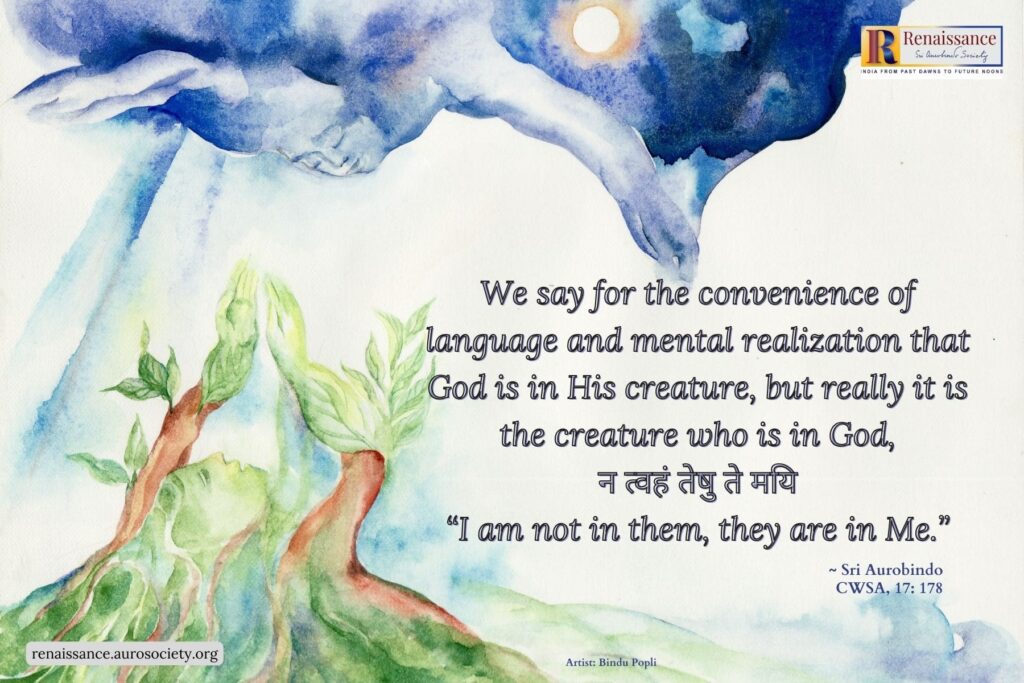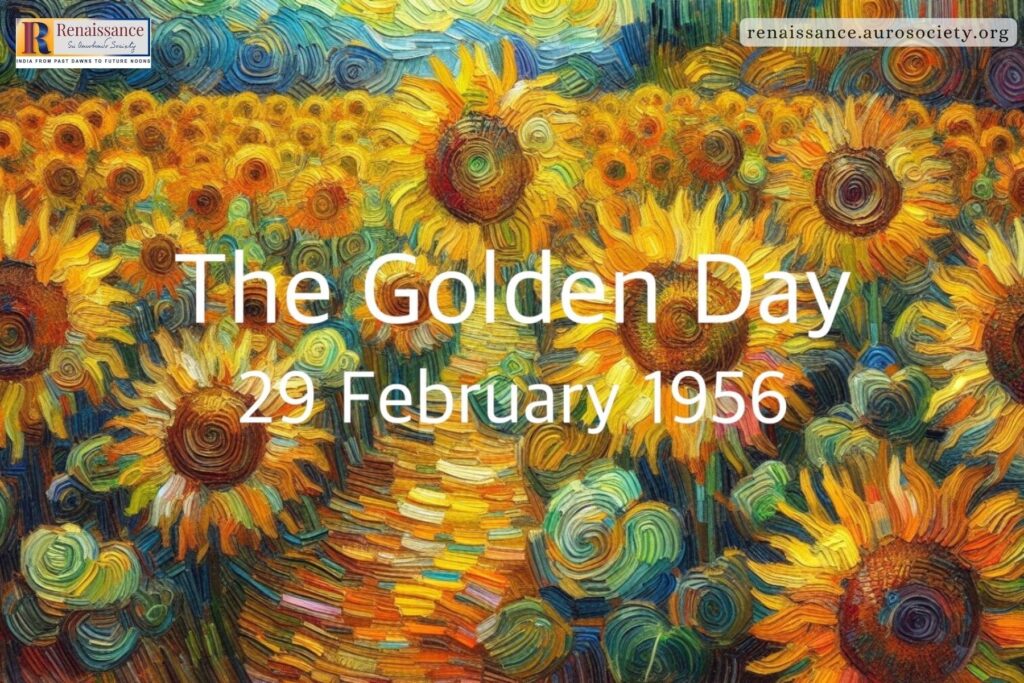Continued from Part 2

Brahman is beyond Space, Time and Causality. Movement and quiescence, duration and eternity, action and inaction, are not terms in which it can be described or contained. In itself it is indescribable. But turned towards manifestation, it is poised in the two statuses, the stable and the motional; Space, Time, Causality are terms of its manifestation, its own self-extension. It contains all these as their continent and yet transcends them. Moveless, it contains and holds beyond all movement. The Gods, the Powers it puts forth to work out its self-expression cannot, naturally, surpass it; it is always vaster than its own emanations.
The Brahman extends itself variously, not singly in one form. Its consciousness expresses and forms itself in several gradations, organises itself around several principles, each active in the forefront on its level. These extensions, Sri Aurobindo points out, are in the ancient system septuple, known by the vyahritis: Bhuh, Bhuvah, Suvah, Mahas, Jana, Tapas and Satya which in modern language are the principles and planes based on them of Matter, Life, Mind, Idea, Bliss, Consciousness and Force, and Existence.
Thus the text says that in his own extension as the Mother of things,—Earth, the physical matter, He, the Brahman as the Life-Force wakes and spreads Himself, i.e., enlivening all that enters into and sets aflow the Waters which, in the Vedic system, represent currents of conscious being. “. . . the Waters, otherwise called the seven streams or the seven fostering Cows, are the Vedic symbol for the seven cosmic principles and their activities, three inferior, the physical, vital and mental, four superior, the divine Truth, the divine Bliss, the divine Will and Consciousness, and the divine Being. On this conception also is founded the ancient idea of the seven worlds in each of which the seven principles are separately active by their various harmonies.” (CWSA, Vol. 17, p. 6)[1]
Thus it is He that is the origin, the end and the container of the things; creating, he indwells the forms of his manifestation, enjoys variously his thousand abodes. He is the One, the same everywhere. And if each individual formation behaves and acts as if it is a separate entity, different from others, it is because it is clouded in its outer consciousness, it has temporarily lost touch with the unifying knowledge and consciousness at its back—that which sustains it as well as it does all the rest in a common extension.
The moment one realises this truth effectively and gets aware of the one Self in all and as the All, sets the right perspective of the union of all in the One Self, the sense of separativity loses its validity and with it goes the need to affirm oneself at the cost of others, the sense of opposition from other forms. Thus declares the Upanishad:
यस्तु सर्वाणि भूतानि आत्मन्येवानुपश्यति।
सर्वभूतेषु चात्मानं ततो न विजुगुप्सते ॥६॥
yastu sarvāṇi bhūtāni ātmanyevānupaśyati |
sarvabhūteṣu cātmānaṁ tato na vijugupsate ||
“But he who sees everywhere the Self in all existences and all existences in the Self, shrinks not thereafter from aught.” (CWSA, Vol. 17, p. 7)
यस्मिन् सर्वाणि भूतानि आत्मैवाभूद् विजानतः।
तत्र को मोहः कः शोक एकत्वमनुपश्यतः ॥७॥
yasmin sarvāṇi bhūtāni ātmaivābhūd vijānataḥ |
tatra ko mohaḥ kaḥ śoka ekatvamanupaśyataḥ ||
“He in whom it is the Self-Being that has become all existences that are Becomings, for he has the perfect knowledge, how shall he be deluded, whence shall he have grief who sees everywhere oneness?” (CWSA, Vol. 17, p. 7)
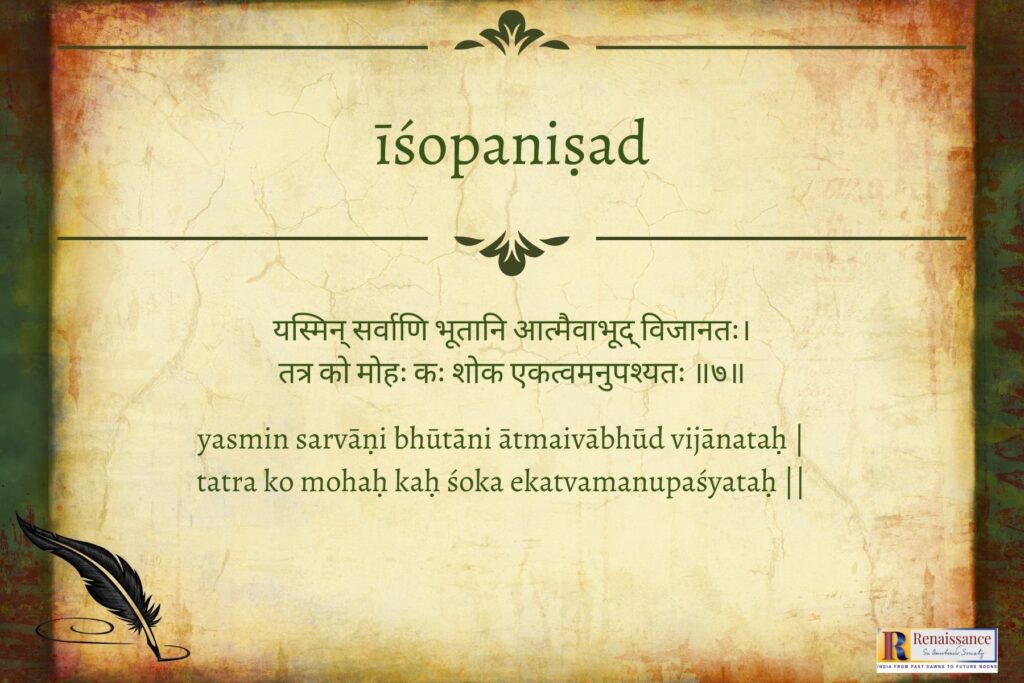
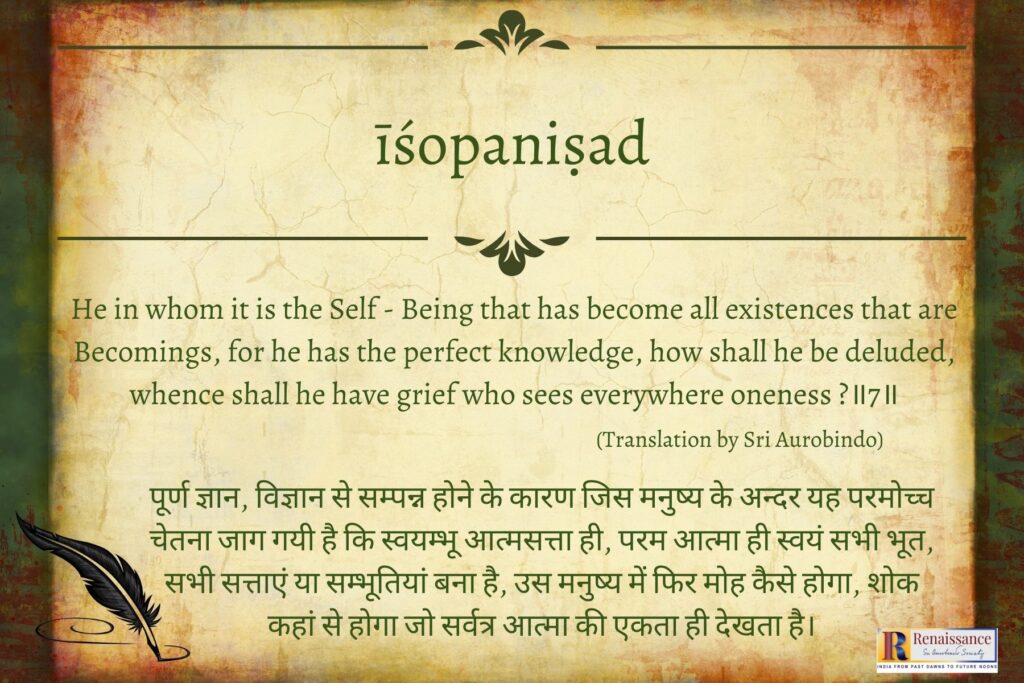
For such a one there is no Conflict and Sorrow; for “for all grief is born of the shrinking of the ego from the contacts of existence, its sense of fear, weakness, want, dislike, etc.; and this is born from the delusion of separate existence, the sense of being my separate ego exposed to all these contacts of so much that is not myself. Get rid of this, see oneness everywhere, be the One manifesting Himself in all creatures; ego will disappear; desire born of the sense of not being this, not having that, will disappear; the free inalienable delight of the One in His own existence will take the place of desire and its satisfactions and dissatisfactions.” (Sri Aurobindo, CWSA, Vol. 17, pp. 87-88)
That is not all. The truth of Brahman in manifestation is not confined to the subjective projection as the Self of all things. It is not merely an impersonal Being in which the becoming takes place. Brahman is also He, the Person who originates, inhabits and governs the Universe.
स पर्यगाच्छुक्रमकायमव्रणमस्नाविरं शुद्धमपापविद्धम्।
कविर्मनीषी परिभूः स्वयम्भूर्याथातथ्यतोऽर्थान् व्यदधात् शाश्वतीभ्यः समाभ्यः ॥८॥
sa paryagācchukramakāyamavraṇamasnāviraṁ śuddhamapāpaviddham |
kavirmanīṣī paribhūḥ svayambhūryāthātathyato’rthān vyadadhāt śāśvatībhyaḥ samābhyaḥ ||
“It is He that has gone abroad —That which is bright, bodiless, without scar of imperfection, without sinews, pure, unpierced by evil. The Seer, the Thinker, the One who becomes everywhere, the Self-existent has ordered objects perfectly according to their nature from years sempiternal.” (CWSA, Vol. 17, p. 7)
In his going abroad, that is, in his self-extension there are, it should be noted, two aspects: one an Infinite Immutability and the other Mutation, a working out of possibilities in Time, Space and Causality. The Upanishad speaks of the former—the Pure Immutable as the bright, self-luminous without a shadow, bodiless, unlimited by form and division, without scar of imperfection and sinews, flawless, unaffected by the play of clashing circumstances and not subject to the currents and cross currents of diminution and increase, pure and unpierced by evil, that is, not contaminated by Ignorance and its issue, the wrong, the crooked as opposed to what is normally right and straight.
The same Absolute is spoken of in the other aspect successively, as the Kavi, the Seer, who before he proceeds to manifest sees in his luminous vision the Truth, the principles of things that are to manifest, then, as the Manishi, Thinker, who conceives and thinks out the processes in the evolution of the possibilities, the Paribhu, He who eventuates, becomes everywhere, in Space and Time as impelled by the Manishi. It is all, it must be noted, a one becoming of the Self-existent Purusha who moves into these three poises, seeing, conceiving and fixing things in accord with the Truth which is being expressed, the eternal Truth which forms and governs the nature of each formation as its innate Law.
Sri Aurobindo writes in his commentary:
“The Lord appears to us in the relative notion of the process of things first as Kavi, the Wise, the Seer. The Kavi sees the Truth in itself, the truth in its becoming, in its essence, possibilities, actuality. He contains all that in the Idea, the Vijnana, called the Truth and Law, Satyam Ritam.
“He contains it comprehensively, not piecemeal; the Truth and Law of things is the Brihat, the Large. Viewed by itself, the realm of Vijnana would seem a realm of predetermination, of concentration, of compelling seed-state. But it is a determination not in previous Time, but in perpetual Time; a Fate compelled by the Soul, not compelling it, compelling rather the action and result, present in the expansion of the movement as well as in the concentration of the Idea. Therefore the truth of the Soul is freedom and mastery, not subjection and bondage. Purusha commands Prakriti, Prakriti does not compel Purusha. Na karma lipyate nare.
“The Manishi takes his stand in the possibilities. He has behind him the freedom of the Infinite and brings it in as a background for the determination of the finite. Therefore every action in the world seems to emerge from a balancing and clashing of various possibilities. None of these, however, are effective in the determination except by their secret consonance with the Law of that which has to become. The Kavi is in the Manishi and upholds him in his working. But viewed by itself the realm of the Manishi would seem to be a state of plasticity, of freewill, of the interaction of forces, but of a free-will in thought which is met by a fate in things.
“For the action of the Manishi is meant to eventuate in the becoming of the Paribhu. The Paribhu, called also Virat, extends Himself in the realm of eventualities. He fulfils what is contained in the Truth, what works out in the possibilities reflected by the mind, what appears to us as the fact objectively realised. The realm of Virat would seem, if taken separately, to be that of a Law and Predetermination which compels all things that evolve in that realm,—the iron chain of Karma, the rule of mechanical necessity, the despotism of an inexplicable Law.”
(CWSA, Vol. 17, pp. 48-49)
Thus the Movement has its truth as much as the Stability; multiplicity is as real as unity. Both are twin ends of the one pole of Reality in manifestation and should be comprehended as such. To ignore or deny one and accept and pursue only the other is to shut oneself from the full reality of things. To accept the truth of both in a large vision and seek to realise it in one’s own life is the path of wisdom.
Notes:
[1] In a note on apas, Sri Aurobindo points out: “Apas, as it is accentuated in the version of the White Yajurveda, can mean only “waters”. If this accentuation is disregarded, we may take it as the singular apas, work, action. Shankara, however, renders it by the plural, works. The difficulty only arises because the true Vedic sense of the word had been forgotten and it came to be taken as referring to the fourth of the five elemental states of Matter, the liquid. Such a reference would be entirely irrelevant to the context.” (CWSA, Vol. 17, p. 6)
To be continued…

Read previous parts: Part 1, Part 2
~ Graphic Design: Biswajita Mohapatra

